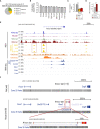Transcriptional signature of islet neogenesis-associated protein peptide-treated rat pancreatic islets reveals induction of novel long non-coding RNAs
- PMID: 37842306
- PMCID: PMC10570750
- DOI: 10.3389/fendo.2023.1226615
Transcriptional signature of islet neogenesis-associated protein peptide-treated rat pancreatic islets reveals induction of novel long non-coding RNAs
Abstract
Background: Diabetes mellitus is characterized by chronic hyperglycemia with loss of β-cell function and mass. An attractive therapeutic approach to treat patients with diabetes in a non-invasive way is to harness the innate regenerative potential of the pancreas. The Islet Neogenesis-Associated Protein pentadecapeptide (INGAP-PP) has been shown to induce β-cell regeneration and improve their function in rodents. To investigate its possible mechanism of action, we report here the global transcriptional effects induced by the short-term INGAP-PP in vitro treatment of adult rat pancreatic islets.
Methods and findings: Rat pancreatic islets were cultured in vitro in the presence of INGAP-PP for 4 days, and RNA-seq was generated from triplicate treated and control islet samples. We performed a de novo rat gene annotation based on the alignment of RNA-seq reads. The list of INGAP-PP-regulated genes was integrated with epigenomic data. Using the new gene annotation generated in this work, we quantified RNA-seq data profiled in INS-1 cells treated with IL1β, IL1β+Calcipotriol (a vitamin D agonist) or vehicle, and single-cell RNA-seq data profiled in rat pancreatic islets. We found 1,669 differentially expressed genes by INGAP-PP treatment, including dozens of previously unannotated rat transcripts. Genes differentially expressed by the INGAP-PP treatment included a subset of upregulated transcripts that are associated with vitamin D receptor activation. Supported by epigenomic and single-cell RNA-seq data, we identified 9 previously unannotated long noncoding RNAs (lncRNAs) upregulated by INGAP-PP, some of which are also differentially regulated by IL1β and vitamin D in β-cells. These include Ri-lnc1, which is enriched in mature β-cells.
Conclusions: Our results reveal the transcriptional program that could explain the enhancement of INGAP-PP-mediated physiological effects on β-cell mass and function. We identified novel lncRNAs that are induced by INGAP-PP in rat islets, some of which are selectively expressed in pancreatic β-cells and downregulated by IL1β treatment of INS-1 cells. Our results suggest a relevant function for Ri-lnc1 in β-cells. These findings are expected to provide the basis for a deeper understanding of islet translational results from rodents to humans, with the ultimate goal of designing new therapies for people with diabetes.
Keywords: INGAP; Ri-lnc1; beta cell (β-cell); islet; long noncoding RNA (IncRNA); pancreas; rat; regeneration.
Copyright © 2023 Romero, Heidenreich, Román, Algañarás, Nazer, Gagliardino, Maiztegui, Flores and Rodríguez-Seguí.
Conflict of interest statement
The authors declare that the research was conducted in the absence of any commercial or financial relationships that could be construed as a potential conflict of interest.
Figures





Similar articles
-
Islet Neogenesis Associated Protein (INGAP) modulates gene expression in cultured neonatal rat islets.Regul Pept. 2006 Sep 11;136(1-3):78-84. doi: 10.1016/j.regpep.2006.04.015. Epub 2006 Jun 9. Regul Pept. 2006. PMID: 16764950
-
Effects of islet neogenesis-associated protein pentadecapeptide on cell mass and insulin secretion of pancreatic β-cells.J Endocrinol Invest. 2012 Jul;35(7):634-9. doi: 10.3275/7922. Epub 2011 Sep 23. J Endocrinol Invest. 2012. PMID: 21945952
-
INGAP-related pentadecapeptide: its modulatory effect upon insulin secretion.Regul Pept. 2005 Nov;131(1-3):97-102. doi: 10.1016/j.regpep.2005.07.003. Regul Pept. 2005. PMID: 16084603
-
The role of islet neogenesis-associated protein (INGAP) in islet neogenesis.Cell Biochem Biophys. 2007;48(2-3):127-37. doi: 10.1007/s12013-007-0028-3. Cell Biochem Biophys. 2007. PMID: 17709882 Review.
-
The role of islet neogeneis-associated protein (INGAP) in pancreatic islet neogenesis.Curr Protein Pept Sci. 2009 Feb;10(1):37-45. doi: 10.2174/138920309787315211. Curr Protein Pept Sci. 2009. PMID: 19275671 Review.
References
MeSH terms
Substances
LinkOut - more resources
Full Text Sources
Medical
Molecular Biology Databases
Miscellaneous

